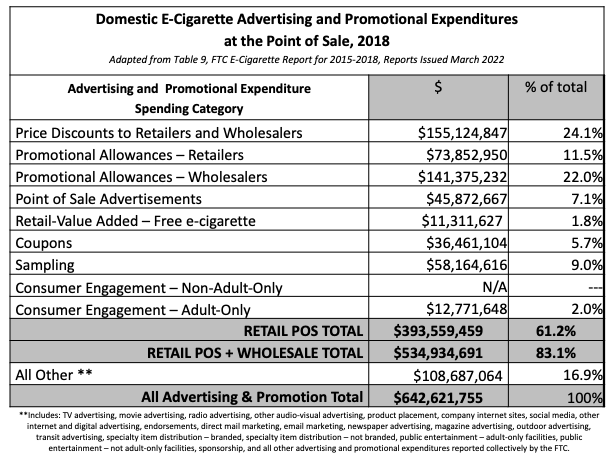The Federal Trade Commission (FTC) has issued reports on tobacco companies’ marketing expenditures for cigarettes and smokeless tobacco for decades; however in October 2019, the FTC issued orders to 6 major e-cigarette companies (Fontem US, Inc.; JUUL Labs, Inc.; Logic Technology Department LLC; NJOY, LLC; Nu Mark LLC; and R.J. Reynolds Vapor Company), seeking information on their sales, advertising, and promotional activities from 2015-2018. On March 17, 2022, the FTC published their first report on e-cigarettes using that data.
Sales
The data show that most e-cigarette sales are happening at retail stores – representing 88.3% of dollar sales in 2015 and growing to 92.1% in 2018.
 Also evident is the rise in popularity of sweet, fruity flavors that have helped drive youth e-cigarette use. In 2015, tobacco-flavored cartridges accounted for nearly half (47.2%) of all cartridges sold or given away, but only 21% in 2018. The popularity of menthol stayed fairly constant over this time period – comprising 39% of cartridge sales in 2015 and 36.9% in 2018. Similar trends occurred with disposable e-cigarettes. The report also shows the rise in cartridge “pod mod” style e-cigarettes like Juul, with cartridge systems comprising 85.5% of the companies’ sales in 2015 and growing to 96.3% of sales in 2018.
Also evident is the rise in popularity of sweet, fruity flavors that have helped drive youth e-cigarette use. In 2015, tobacco-flavored cartridges accounted for nearly half (47.2%) of all cartridges sold or given away, but only 21% in 2018. The popularity of menthol stayed fairly constant over this time period – comprising 39% of cartridge sales in 2015 and 36.9% in 2018. Similar trends occurred with disposable e-cigarettes. The report also shows the rise in cartridge “pod mod” style e-cigarettes like Juul, with cartridge systems comprising 85.5% of the companies’ sales in 2015 and growing to 96.3% of sales in 2018.
Note that these sales numbers are prior to any federal regulations on flavored e-cigarettes, after which we saw a decrease in the sale of fruity flavored cartridges and a rise in menthol sales, as well as a steep rise in flavored disposable e-cigarette sales. As of 2021, disposables were the most popular type of e-cigarettes, with Puff Bar emerging as the most popular brand. In September 2021, the FTC issued another order to the major e-cigarette companies, requesting information on their 2019-2020 sales, advertising, and promotional data, so we expect to see another report from the FTC with more recent data sometime in the future.
The report also documents the rise in average nicotine concentrations, with the average nicotine concentration in cartridges rising from 47.5 mg/ml in 2015 to 49.4 mg/ml in 2018, and the average nicotine concentration in disposable e-cigarettes rose from 25mg/ml in 2015 to 39.5 mg/ml in 2018. Nicotine concentrations remain high today.
Advertising & Promotions
The report shows that, as is the case with tobacco industry marketing expenditures for cigarettes and smokeless tobacco, the retail setting is where e-cigarette companies are spending the vast majority of their money, with over 61% spent directly in the retail setting and over 83% when factoring in promotional allowances paid to wholesalers.
Between 2015-2018:
 Overall expenditures and promotion for e-cigarette products more than tripled, rising from $197.8 million in 2015 to $643.6 million in 2018.
Overall expenditures and promotion for e-cigarette products more than tripled, rising from $197.8 million in 2015 to $643.6 million in 2018.- Price discounts paid to retailers and wholesalers grew nearly 14x, from $11.2 million in 2015 to $155.1 million in 2018. These discounts reduce the price of e-cigarette products to consumers and include off invoice discounts, buy downs, voluntary price reductions, and trade programs.
- Promotional allowances paid to retailers and wholesalers to facilitate the sale or placement of e-cigarette products grew from $28.4 million paid to retailers and $21.1 million paid to wholesalers in 2015 to $73.9 million paid to retailers and $141.4 million paid to wholesalers in 2018. For retailers, this includes payments for stocking, shelving, displaying, and merchandising brands, volume rebates, incentive payments, and the cost of e-cigarette products given to retailers for free for subsequent resale to consumers. For wholesalers, this includes payments for volume rebates, incentive payments, value-added services, promotional execution, and satisfaction of reporting requirements.
- Spending on sampling and distribution of free and deeply discounted e-cigarette products more than doubled, rising from $23 million in 2015 to $58.2 million in 2018. Note that many companies offer products at $1 or some other nominal cost to get around the FDA’s ban on free samples.
- Expenditures on point-of-sale advertising more than tripled, rising from $13.4 million in 2015 to $45.9 million in 2018.
- Expenditures on coupons grew from $22.5 million in 2015 to $36.5 million in 2018.
E-cigarette companies are spending their money where they know it matters. They’re aiming to keep their products cheap and visible in the retail environment. Research shows that exposure to tobacco marketing can cause youth to start smoking, keep people who currently smoke hooked, and make it harder for people to quit and stay quit. E-cigarette companies know that keeping prices low drives use. While research on the impacts of e-cigarette pricing is less extensive than on the impacts of cigarette pricing, the existing data show that both disposable and reusable e-cigarette sales are also responsive to price.[1] When e-cigarette prices increase, sales decrease, particularly among price-sensitive groups like youth. We know that lower prices, along with coupons and price discounts, encourage youth to start smoking and move them along from experimentation to regular cigarette use.[2] E-cigarette companies engage in these practices because the same thing is likely to happen with e-cigarettes.

To learn more about e-cigarette sales and marketing expenditures, read the press release from the FTC or download the full report. To learn more about how tobacco companies spend their marketing dollars on cigarettes and smokeless tobacco, read our summary on the War in the Store. Learn more about e-cigarettes at the point of sale in our evidence summary.


